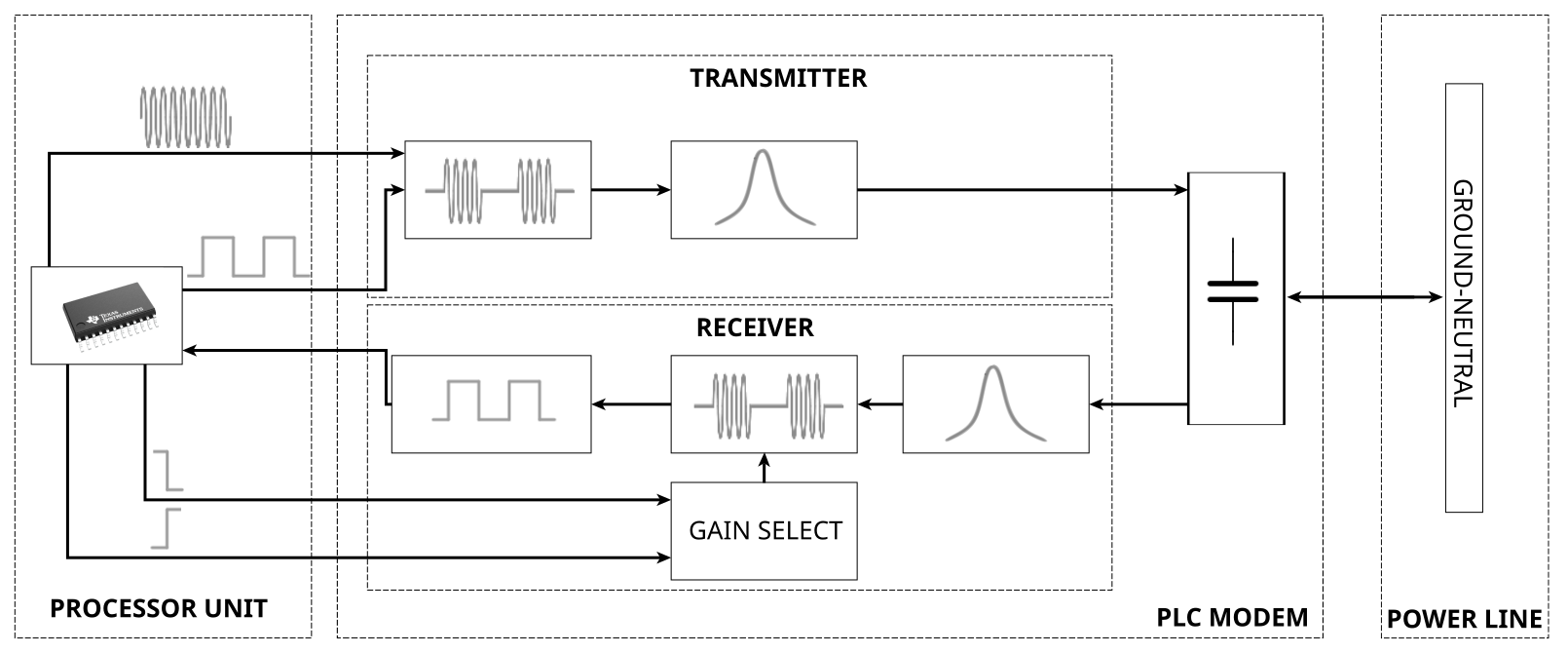Simple and Low-Cost PLC Modem for IoT Applications
Keywords:
Internet of things, IoT, Modem, Power line communication, PLCAbstract
We present in this paper a simple and low-cost Power Line Communication (PLC) modem for Internet of Things (IoT) applications. The proposed modem implements a simple on-off-keying (OOK) modulation/demodulation with only discrete electronic components, not requiring complex ICs, such as processing units. It uses the ground and neutral wires as a channel communication, eliminating the need for complex isolation circuitry. To improve its robustness to noise, the developed PLC modem includes an automatic receiver gain adjustment and a transmitter sweep carrier frequency algorithm. Laboratory tests show that the developed PLC modem is capable of transmitting data at 9,600 bps with no errors if the noise spectral density in the power line is below 111 nVRMS2/Hz in the bandwidth of 150 kHz to 500 kHz. The system was also evaluated in a residential power network, where it presented a bit error rate below 1.21%. Due to its low cost, the developed PLC modem is suitable for low data rate IoT applications such as energy consumption monitoring, appliance monitoring and control, environmental monitoring (temperature, humidity, luminosity), security monitoring (presence sensors), etc.
Downloads
References
G. Bedi, G. K. Venayagamoorthy, R. Singh, R. R. Brooks, and K.-C. Wang, “Review of Internet of Things (IoT) in Electric Power and Energy Systems,” IEEE Internet Things J., vol. 5, no. 2, pp. 847–870, 2018.
D. Minoli, K. Sohraby, and B. Occhiogrosso, “IoT Considerations, Requirements, and Architectures for Smart Buildings – Energy Optimization and Next Generation Building Management Systems,” IEEE Internet Things J., vol. 4, no. 1, pp. 269–283, 2017.
Q. Sun et al., “A Comprehensive Review of Smart Energy Meters in Intelligent Energy Networks,” IEEE Internet Things J., vol. PP, no. 99, pp. 1–1, 2015.
E. Spano, S. Di Pascoli, and G. Iannaccone, “Internet-of-things infrastructure as a platform for distributed measurement applications,” Conf. Rec. - IEEE Instrum. Meas. Technol. Conf., vol. 2015-July, pp. 1927–1932, 2015.
M. Rizzi, P. Ferrari, A. Flammini, and E. Sisinni, “Evaluation of the IoT LoRaWAN Solution for Distributed Measurement Applications,” IEEE Trans. Instrum. Meas., vol. 66, no. 12, pp. 3340–3349, 2017.
M. Oliveira Leme, F. Trojan, A. C. Francisco, and A. A. Paula Xavier, “Digital Energy Management for Houses and Small Industries Based on a Low-cost Hardware,” IEEE Lat. Am. Trans., vol. 14, no. 10, pp. 4275–4278, 2016.
H. Ghayvat, S. C. Mukhopadhyay, and X. Gui, “Issues and mitigation of interference, attenuation and direction of arrival in IEEE 802.15.4/ZigBee to wireless sensors and networks based smart building,” Meas. J. Int. Meas. Confed., vol. 86, pp. 209–226, 2016.
S. Shoaib, X. Chen, and I. Llewellyn, “Increasing the Effective Range of Smart Meter Home Area Network,” IEEE Antennas Wirel. Propag. Lett., vol. 16, pp. 2898–2901, 2017.
S. Barker, D. Irwin, and P. Shenoy, “Pervasive Energy Monitoring and Control Through Low-Bandwidth Power Line Communication,” IEEE Internet Things J., vol. 4, no. 5, pp. 1349–1359, 2017.
H Gassara, F Rouissi, A Ghazel, “Statistical Characterization of the Indoor Low-Voltage Narrowband Power Line Communication Channel,” IEEE Trans. Electromagn. Compat., vol. 56, no. 1, pp. 123–131, 2013.
D. Chariag, D. Guezgouz, J. C. Le Bunetel, and Y. Raingeaud, “Modeling and simulation of temporal variation of channel and noise in indoor power-line network,” IEEE Trans. Power Deliv., vol. 27, no. 4, pp. 1800–1808, 2012.
T. R. Oliveira, A. A. M. Picorone, S. L. Netto, and M. V. Ribeiro, “Characterization of Brazilian in-home power line channels for data communication,” Electr. Power Syst. Res., vol. 150, pp. 188–197, 2017.
C. Cano, A. Pittolo, D. Malone, L. Lampe, A. M. Tonello, and A. Dabak, “State-of-the-art in Power Line Communications : from the Applications to the Medium,” vol. 8716, no. c, pp. 1–19, 2016, doi: 10.1109/JSAC.2016.2566018.
D. S. Kim, S. Y. Lee, K. Y. Wang, J. C. Choi, and D. J. Chung, “A power line communication modem based on adaptively received signal detection for networked home appliances,” IEEE Trans. Consum. Electron., vol. 53, no. 3, pp. 864–870, 2007.
Y. T. Hwang and S. W. Chen, “Hardware efficient design for narrow band power line communication modem,” IEEE Reg. 10 Annu. Int. Conf. Proceedings/TENCON, pp. 508–512, 2011.
Y. F. Chen and T. D. Chiueh, “Baseband transceiver design of a 128-Kbps power-line modem for household applications,” IEEE Trans. Power Deliv., vol. 17, no. 2, pp. 338–344, 2002.
B. Tiru and P. Boruah, “Design and Testing of a Suitable Transceiver for Full Duplex Communication in Indoor Power Line,” IETE J. Res., vol. 56, no. 5, p. 286, 2010.
C.-H. Wang, C.-Y. Chen, and T.-P. Sun, “Circuit implementation of OOK modulation for low-speed power line communication using X10 standard,” pp. 248–453, 2011.
“Noise Measurements Using a Teledyne LeCroy Oscilloscope,” 2013.
T. Instruments, “MIXED SIGNAL MICROCONTROLLER 1 MSP430AFE2x3 MSP430AFE2x2 MSP430AFE2x1,” 2011.
R. Pi, “Raspberry Pi Compute Module ( CM1 ) Raspberry Pi Compute Module 3 ( CM3 ) Raspberry Pi Compute Module 3 Lite ( CM3L ),” vol. 3, no. October, pp. 0–21, 2016.


